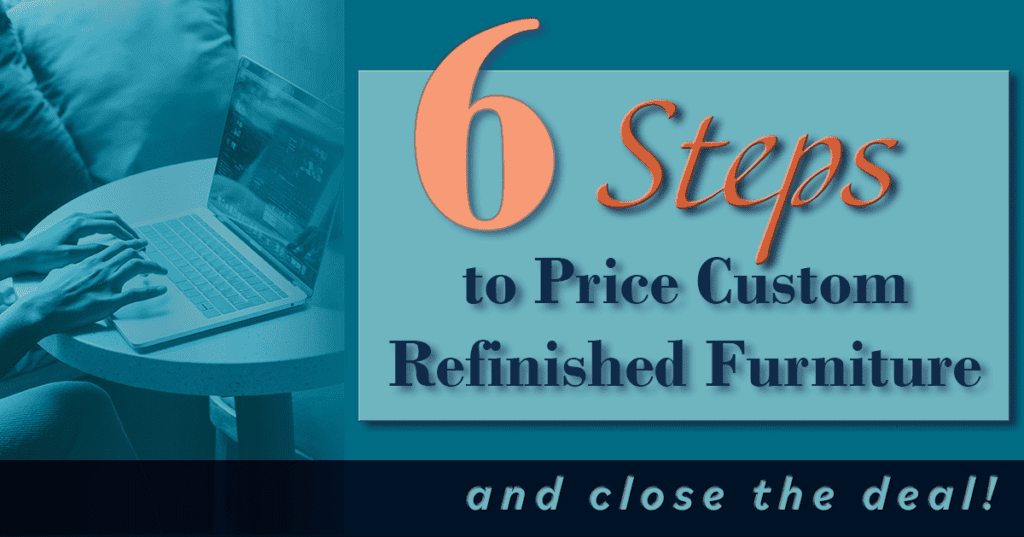You’ve learned how to generate sales leads for commissioned pieces, and now a hot sales lead has requested a price on custom refinished furniture; well done! However, you must close the deal to convert them into clients. How well you price your quote will determine whether or not you close the sale. To price the quote, you must determine a reasonable amount that satisfies the customer and covers your business costs. In the next article, once you have a price, we will look at creating a quote for refinishing furniture.
So, how do you price custom refinished furniture? There are six key steps to price custom refinished furniture correctly.
To price custom refinished furniture correctly requires understanding the costs that go into the project and your time outside of working on the piece directly. In addition to your time and materials, you must understand the project’s size and scope, market area, your skills, local market prices, and brand strategy. For those building their business, you should have developed a brand strategy suited to your target market and a sales strategy. You can learn how to develop these business strategies in the Business Management Course.

The Furniture
Before you can price custom refinished furniture, you will need to see the furniture. Sometimes the negotiations are done electronically. The sales lead will send you photos of the piece or pieces. Ensure you get the piece’s dimensions, materials (and they may get this wrong), other photos like the room it is going into and inspiration photos, if possible. Ask them to send photos of any visible damage or areas of concern. You may wish to see the piece in person – ensure you account for this time and travel costs in your quote.
Buying or Supplying Furniture
Sometimes a sales lead will ask you to supply the furniture – you may have furniture in stock or need to find a suitable piece to buy. I can tell you from experience it is much better when they already have a piece, or you have one in stock. If you have to find them a piece of furniture or they start shopping, it can take a lot of back and forth to find the right one, or they might buy a cheap, poorly made piece (this can happen if they own it too).
If you source a piece for the person, consider how you will charge out the time you spend looking – is the person willing to pay you to search? If they are supplying a piece, whether one they own or a newly purchased one, ensure they are clear on what quality is best – solid wood or veneer and avoid particleboard and laminates.
I have had clients buy a piece they had a seller deliver and found it falling apart and fake wood. The client then had to arrange to pick it up and bring a different one. This change meant reevaluating my quote, not to mention the time it took going back and forth about the rejected piece.
Pricing Designed vs Commissioned Pieces
Whether providing a price for custom refinished furniture or pricing the pieces you design and sell on Marketplace, you can follow the nearly the same steps. Except instead of developing the design yourself, you are now designing a piece to match the customer’s expectations and providing them with a quote outlining your steps to meet those expectations.
Depending on how you run your business, you may choose not to stage and photograph the completed commissioned piece. However, taking professional photos of your completed commissioned furniture is an excellent way to build your business portfolio and create social media content. You can also get reviews from your client on the photos you post.
6 Steps to Price custom Refinished Furniture
1. Time and Materials or a Pricing Guideline
Many furniture refinishers charge by the hour, plus the cost of materials. You’ll need to estimate how many hours you will take to complete the project and factor in the cost of things like sandpaper, paint, and other finishes.
Time – Consider too how long it will take to create the quote, buy the materials (do you have to shop for hardware or fabric?), and perform the work on the piece. Your time must account for your overhead costs if you charge by the hour.
Materials – Do you use consumables like rags, chip brushes, disposable gloves, sandpaper, and other materials besides the paint, stain, finishes, and items like transfers? Have you accounted for these in your pricing? Marking up your materials or including a shop fee can help offset these costs. You do not need to include the markup or shop fee as a line item on your quote, but add it to the price.
Having a good system to track your inventory and product prices is crucial to provide accurate materials estimates. Check out my video on the Cost of Goods Sold and Inventory Workbooks and the Business Management course.
I always add a markup to any custom purchases for the quote – this is standard industry practice. If the customer wants to shop for items, like custom hardware and fabrics, and bring them to you, they can pay the market price.
Using a pricing guideline
I don’t quote time and materials, except in specific circumstances. I have developed a pricing guideline to streamline how I set a price for custom refinished furniture. Having a customized guideline with many variables allows me to set a price quickly – although it still takes time and attention to detail.
I call it a guideline because I always consider the actual piece when preparing a quote. The other factors above to price custom furniture went into generating the guideline prices, and then I refine the quote based on the actual piece or pieces. Market prices are also a significant factor. For example, Home Depot has a wax product that I paid $22 for when I bought it in 2020, and it is now $32.
So, while my pricing guideline has built-in materials included, I need to periodically adjust the prices for inflation. It is crucial to track materials to calculate the cost of goods sold, even if you don’t use the actual materials when pricing. Check out the video on Cost of Goods sold and Inventory Workbooks I linked to above.
Caution
Lots of posts tell you how to price custom refinished furniture. But you should proceed cautiously if they give you a specific price or price list. As explained earlier, those prices are only as good as your understanding of how to price custom furniture. Ask yourself, do you work at the same speed as someone else? Do you have the same overhead and variable costs on that item?
Some websites might even give you a calculator – but only you can know your business well enough to generate a price. Does that calculator take into consideration your overhead costs? Is there a markup on the materials to cover your consumables? How did they come to that markup? And if they ask you for a markup value, how do you know what amount to set?
If you plan on using a pricing guideline, develop one that suits your business and use it for consistency in quoting.
2. Project Size and Scope
Intricate carvings, transfers, moulds, or multiple paint colours, command a higher price. The larger the piece or number of pieces, the more you charge. This consideration also ties into time and materials: how long it will take to finish the piece and the products it will take.
Damages: Is there a lot of damage, or will the piece require stripping before finishing? Ensure you have a clause in your contract allowing you to charge more for unseen repairs or other problems. Photos do not always reveal structural problems. (We cover creating the quote in the next article!)
I would argue that this step has the most significant margin of error for new refinishers. You need to understand the project’s scope and how much work is involved so that you price the work accurately.
3. Location
Refinishers in urban areas or areas with a high cost of living may charge more than those in rural areas. Will the customer bring the piece to you, or will you pick it up? Include pickup and delivery charges on the quote as a separate line item, or ensure the customer knows your limitations if you cannot provide this service. If you service a larger urban area but live a distance away, you may wish to advertise free pickup and delivery, if feasible, so you can tap into the larger market and charge more.
4. Experience and Expertise
Refinishers with more experience or specialized skills, like expert antique restoration, can charge premium rates. Beginner refinishers should price according to the quality of work performed. If unsure how well your work will hold up over time, you should not charge premium prices and ensure your client knows your limitations.
Do not be afraid to turn down a job that is more than you can handle. You are better off saying so upfront than getting in over your head and causing damage to a client’s piece of furniture. Your experience should come on your own time – buy inexpensive practice pieces to learn new techniques.
Generally, the furniture isn’t the most significant expense; your time, overhead, and materials will be the bulk of the quoted price. However, the client may think your price should be lower because they provide the furniture. If they raise this point, try and tactfully point out that your skills and time to create a custom refinished piece of furniture are what they are purchasing.
5. Market Prices
Research what other furniture refinishers with similar skills and styles in your area charge for similar services. Know that ready-to-purchase pieces from Marketplace will cost less than a commissioned piece of furniture. The reason is that this is a customized, professionally refinished piece. If someone wants you to provide them with a piece designed to their specifications or professionally restored, they will pay more.
However, try to stay within the market price range, or the client may feel you are overcharging. And, not to overstate this, but look at the market prices in the same class of work you provide based on your skills and experience.
6. Brand Strategy
In the Business Management course, you learn how your branding determines your pricing. Do you price low and move many pieces, or price high and attract more discerning buyers?
While many beginners will use market pricing and try and undercut the competition or not trust their skills, experienced refinishers understand how to use a brand strategy to keep their prices high.
Putting it all Together
The more you price custom refinished furniture and the more pieces you complete, the more familiar you will become with the process and getting your prices right. However, you must understand your overhead costs and how your sales generate revenue. Keeping accurate records of your revenue and expenses allows you to analyze your business and find ways to improve your pricing accuracy. You can use bookkeeping software to track your income and expenses and generate business reports:
I have a YouTube bookkeeping video series that walks you through how to set-up your bookkeeping software.
Break-Even and Maximum Profit
There is one more factor that I want to touch on when setting a price for custom refinished furniture. Many new flippers do not adequately understand the concepts behind business management and will overlook overhead costs and underprice their pieces. In the Business Management course, we look at how to price your pieces, whether a custom refinishing or one you are posting for sale. Of course, as noted, if you are new and your skills aren’t well-developed, you need to price lower than more experienced finishers.
If you want to generate a profit and stay in business, you must understand how to price to cover all your costs, not only your inputs. Performing a break-even analysis is the best way to understand your business expenses and how pricing affects your profit margins. The longer you have been in business, the more records you will have and the more accurate the results.
To succeed as a furniture refinisher or furniture flipper, you need to have a firm grasp of the financial side, or you risk making poor decisions that undermine your success.
Check out my video on break-even analysis and maximum profit workbook walkthrough below. Even if you don’t have the workbook (as a student), you will still benefit from the concepts covered in the video. This video covers the concepts taught in the Business Management Course.
Now that you know how to price custom refinished furniture, you must create a quote to get that sale. Check out the next article on How to Create a Quote for Refinishing Furniture.
share this article:








